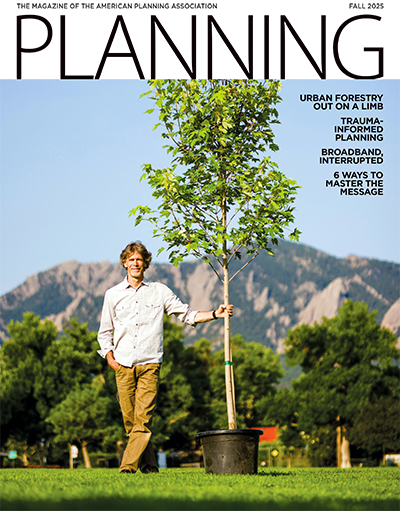Oct. 27, 2022
"I'm a planner first and foremost, and a politician as a means to an end," says Nithya Raman.
One of Los Angeles's newest councilmembers, Raman ran on a platform of addressing homelessness and advancing inclusivity in city government. As a former urban planner and founder of a homelessness nonprofit, she's working to show her fellow Angelenos how issues like homelessness, traffic, and gentrification all stem from a lack of housing inventory.
After a year and a half in office, Raman spoke with me about how her planning knowledge and experience are helping her tackle the biggest issues in her district. This conversation has been edited for length and clarity.
SAUNDERS: Tell me about yourself.
RAMAN: I've represented the Fourth District in Los Angeles as a councilmember for the last year and a half. I'm an urban planner and received my master's degree in urban planning from MIT. I've mostly worked in the nonprofit space, but I've almost always been involved in urban poverty. In India and the U.S., I did a lot of work on the issue of homelessness.
I'm excited to be in this role at a time when housing and land use issues are at the core of what we're grappling with. LA's challenges are not a surprise; they are the outcome of decisions made in the past. I'm excited about playing a role in addressing those issues.
SAUNDERS: What's your district like?
RAMAN: My district runs from the northern part of Silver Lake to the Reseda neighborhood. I serve a lot of the southern San Fernando Valley, a big chunk of the Hollywood Hills, and Los Feliz. We have large districts compared to other cities, and with a weak mayor and a strong council system, there's quite a bit of responsibility placed on councilmembers. There are about 260,000 residents in my district.
SAUNDERS: How did your interest in planning come about?
RAMAN: I'd always been interested in social justice work and human rights. Living in India, I became aware of one of India's largest slums being slated for demolition in Delhi. It had about 100,000 residents, but its demolition received very little coverage in Delhi, especially from English-language news outlets. That made me want to learn more about cities and urban planning more broadly
SAUNDERS: Which came first, your interest in politics or planning?
RAMAN: Planning definitely came first. I would say I'm in politics because I care about LA. I'm an Angeleno and this is a fabulous city. I love to work in the frame of the city. I'm a planner first and foremost, and a politician as a means to an end.
SAUNDERS: Planning can involve a wide range of sub-disciplines: land use policy, housing, infrastructure, development review. Which one intersects most closely with your political role?
RAMAN: The focus in LA is housing and homelessness and its connection to land use policy. It's the realm of urban planning that I live in. I do end up wearing my land use and zoning policy hat on occasion when our council is reviewing development projects, but the real issues are housing policy, renter policy, shelter policy, and urban poverty and homelessness response.
SAUNDERS: What's the most pressing issue among your constituents, and how does your planning background inform your response?
RAMAN: Again, housing and homelessness. My planning education has made me attuned to how history impacts our current moment. Our challenges today demand that we look at our land use past. Our prescription for what ails us as a city is thinking of how to undo our historical decisions around the lack of affordable housing, and my planning education has taught me to look at that history very closely.
A lot of people responding to the crisis of homelessness focus on getting people indoors. And we're doing that, too. Be we didn't get here by accident. Unless we get to the root causes for why we're facing housing insecurity, we won't be able to solve the problem.
SAUNDERS: How can planners help elected or appointed officials build understanding and trust in the planning process?
RAMAN: We need more housing supply, but there is skepticism about the ability of developers to make it happen. It's been hard for Angelenos to trust that the City Council has the tools to address these issues. Planners can play a role by helping to develop a more sophisticated understanding of the tools available. Planners are necessary at the local level because they can help shape the realm of what is possible for city leaders to do.




